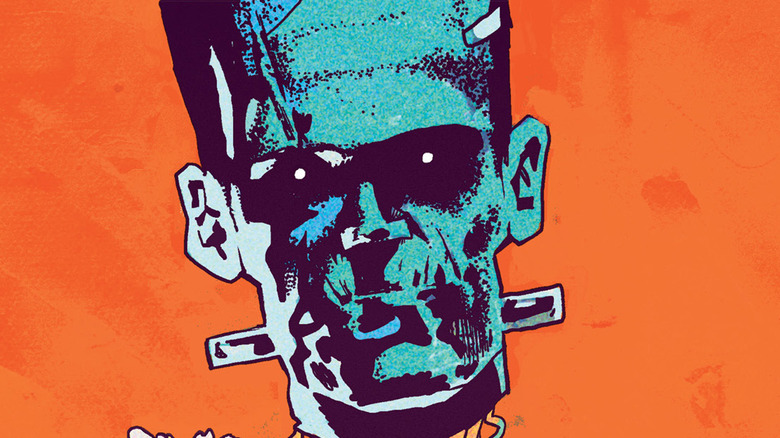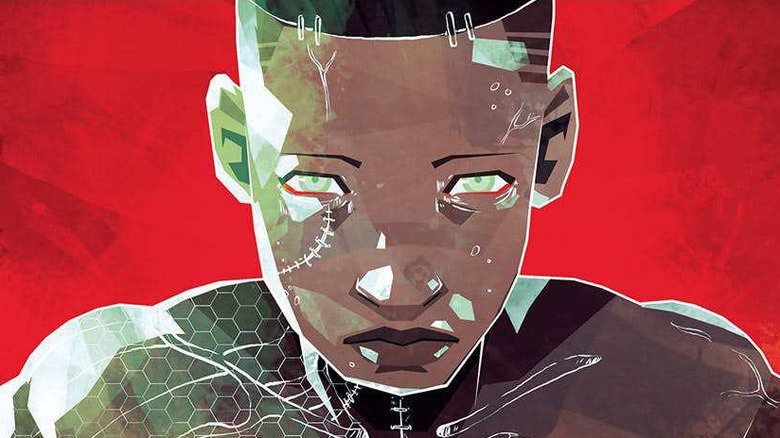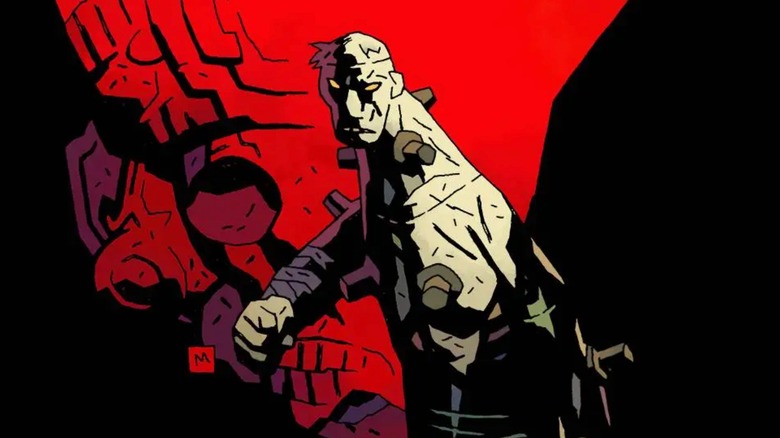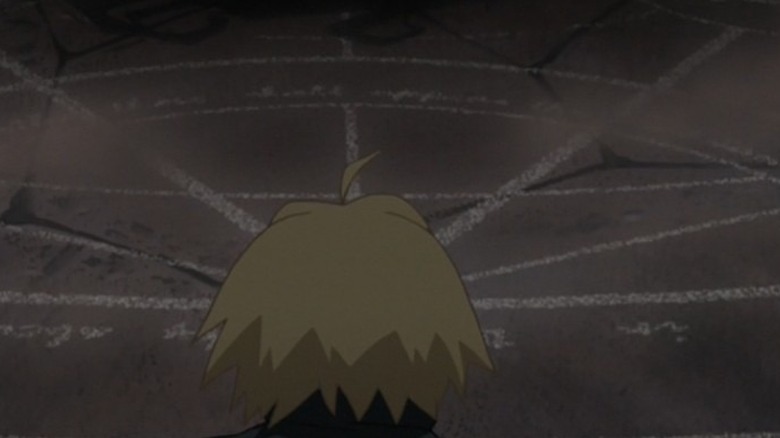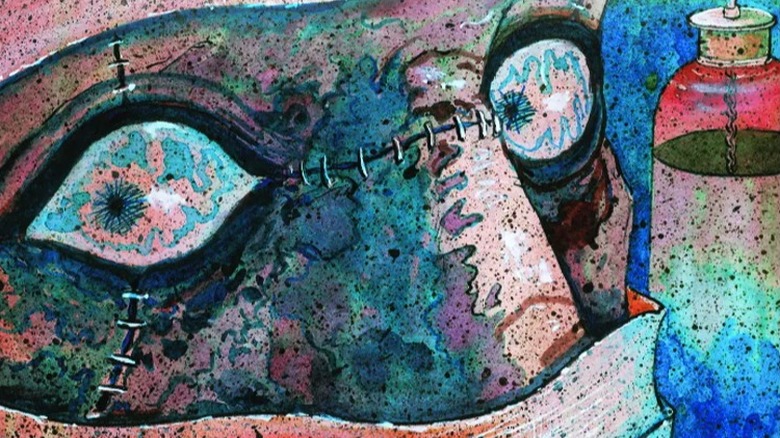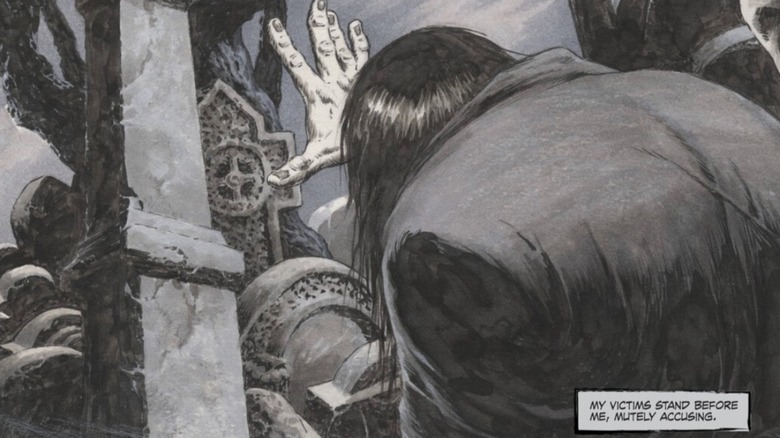The 5 Best Frankenstein Comics, Ranked
Skybound Entertainment (founded by "Invincible" creator Robert Kirkman) has turned into a comic book industry power player thanks to some lucrative licensing deals. Skybound is the current owner of the "Transformers" publishing license, and their ongoing comic (written by Daniel Warren Johnson, currently drawn by Jorge Corona) is an Eisner Award-winning bestseller. Skybound's franchises don't end at the robots in disguise.
The publisher has, since 2023, been releasing a four-issue "Universal Monsters" mini-series, focusing on the classic monster ensemble and telling stories that either reimagine or continue the creatures as they appeared in those films. Kicking off with "Dracula" and continuing with "The Creature from the Black Lagoon Lives!" (read /Film's review of that series here), the third "Universal Monsters" mini-series finally delivers Skybound's "Frankenstein."
"Universal Monsters: Frankenstein" is written and drawn by Michael Walsh, most famous as co-creator of the horror anthology comic "The Silver Coin" (Walsh drew all 15 issues and wrote three of them). Skybound has shared the first two of four "Frankenstein" issues with /Film (to be published on August 28 and September 25, respectively). I've only got half the story, but it's off to a promising start. Walsh emulates James Whale's 1931 "Frankenstein" film more so than Mary Shelley's novel, drawing the Creature like Boris Karloff and the doctor like Colin Clive. (The doctor is also named Henry, not Victor, as he was in Whale's movie.) The main difference is that the son of one of Frankenstein's "organ donors" spots his father being grave-robbed and follows the doctor back to his castle, witnessing the miracle of creation.
The characters in Walsh's "Frankenstein" are shaded in dull grays, evoking the Universal film's palette. The one exception is the Creature, whose green skin and black garb stand out even enshadowed. The comic's backgrounds also have full-color filters, mostly purple or green, offering comely contrast with the characters and extra moodiness.
Everyone knows about the "Frankenstein" movies, but what "Frankenstein" comics are best to whet your appetite for "Universal Monsters: Frankenstein"?
5. Destroyer by Victor LaValle and Dietrich Smith
Victor LaValle's novella "The Ballad of Black Tom" retold H.P. Lovecraft's short story "The Horror at Red Hook" through the eyes of a Black man, both literally and within the text. Lovecraft's importance to horror literature cannot pardon his racism, especially when the horror of "Red Hook" is about urban "decay" brought on supposedly by immigration and miscegenation.
"Frankenstein" does not explicitly deal with themes of race but it is a story about a being who faces ostracization and pre-judgment because of his appearance. That leaves room for a reinterpretation, which LaValle offers in his comic mini-series "Destroyer" (drawn by Dietrich Smith). In this story, the legend of Victor Frankenstein was no mere myth; the Creature still lives to this day. In the U.S. Beltway, African-American Dr. Josephine Baker has rediscovered Frankenstein's research and bestowed life onto her own revenant.
Baker's creature is not a new consciousness like Frankenstein's was, though. It is her young son, Akai, killed when police officers thought his Little League baseball bat was a rifle. Josephine has bestowed her son with power to ensure no one can ever harm him again. In "Destroyer," Baker argues that most "Frankenstein" retellings misrepresent Victor's intentions. It wasn't arrogance or a god complex guiding him, it was grief; he first aspired to defeat death after his own mother passed, after all.
Discussing his inspirations for "Destroyer," LaValle has said that "Frankenstein" must be read with the understanding that Shelley, like Baker, had lost her child (she later lost more) and was grappling with that as she wrote. "Both her story then and mine now are about how far a person might go to get back what was lost," LaValle said.
"Victor LaValle's Destroyer" is available as both a print and digital collected edition.
4. Frankenstein Underground by Mike Mignola, Ben Stenbeck, and Dave Stewart
Mike Mignola, the writer/artist who created Hellboy, paired up his demon hero with Frankenstein's Monster in 2011 with the graphic novel "Hellboy: House of the Living Dead" (drawn by Richard Corben). In 2015, Mignola penned a spin-off for the Creature, "Frankenstein Underground," penciled by Ben Stenbeck and colored by Dave Stewart. (The pair pull off a strong impression of Mignola's gothic style.)
Mignola's Monster looks like Boris Karloff with Hellboy's physique and pale gray, not reptile green, colored skin. Victor Frankenstein, briefly glimpsed in flashbacks, is drawn resembling Peter Cushing from the Hammer "Frankenstein" films. The comic briefly mentions the roots of "Frankenstein" in the writings of ancient alchemists; fitting since Mignola himself is an alchemist of pulp fiction. "Hellboy" is a delicious blend of Jack Kirby, H.P. Lovecraft, and Robert E. Howard, while "Frankenstein Underground" puts the Creature on an adventure right out of its parent comic.
By 1956, the Creature is in South America, having spent over a century traveling the world and meeting nothing but scorn. He carries not only the weight of rejection but the guilt of the lives he took in his crusade against his creator. "Frankenstein Underground" is about the Creature finally falling into Hell — or rather, a subterranean hollow Earth filled with dinosaurs, warrior tribes, and malicious sorcerers.
Mignola is not a religious man, but he was raised Catholic and has said he's more than comfortable using that faith as material in his stories. That shines through in "Frankenstein Underground." #2 reveals that, in 1855, the monster's guilt and suffering became so unbearable he sought refuge in a church, kneeling before a statue of The Virgin Mary and pleading for peace.
The church's minister then attacked him and accused him of being a demon. Mother Mary (colored in golden white, standing out like a light among the comic's dark shading) remains a symbol of hope throughout the rest of the story. If Frankenstein's Monster was not truly born, can he still be one of God's children? If not, then perhaps he can only find peace underground, away from God's eyes.
"Frankenstein Underground" is available as both a print and digital collected edition. Mignola also co-wrote a sequel, "Frankenstein: New World," in 2022.
3. Fullmetal Alchemist by Hiromu Arakawa
Why yes, I do count spiritual adaptations.
Shelley's "Frankenstein" alludes to real-life texts about alchemy. A young Victor is fascinated by the writings of historical alchemists like Paracelsus and Albertus Magnus. His later experiments are him walking in the footsteps of his idols, trying to find the fabled elixir of life with modern science.
"Fullmetal Alchemist," set in a world where alchemy is a real science, is about the brothers Edward and Alphonse Elric. Like Victor Frankenstein, they lose their mother at a young age and dive into the pursuit of knowledge, hoping to conquer death. When they complete their experiment to bring their mother back to life? It ends in disaster. To LaValle's aforementioned point, grief is the only emotion that could push someone to try and cheat death.
Hiromu Arakawa also wrote a comedy manga called "Raiden-18," about a mad scientist who brings to life a Frankenstein's monster to be her assistant/boyfriend. I've argued before and will again, though, that "Fullmetal Alchemist" is her work most like Shelley's. The manga shares themes with "Frankenstein" such as the folly of humans playing god, the responsibility of creation, the dangers of taking science past its natural limits, and more.
In alchemic theory, a homunculus is an artificial being created by alchemy — sometimes depicted as a small human that dwells in a jar. In "Fullmetal Alchemist," one such dwarf in a flask is the series' main villain. In James Whale's "Bride of Frankenstein," Dr. Pretorius (Ernest Thesiger) creates several homunculi while trying to ape Dr. Frankenstein's experiments. The Creature himself could be considered a homunculus, and his maker an alchemist. Too bad Victor's strength of will was less than fullmetal.
"Fullmetal Alchemist" is available digitally and in numerous prints: a 27-volume paperback set, nine-volume 3-in-1 paperbacks, and 18-volume "Fullmetal" deluxe hardcovers.
2. Frankenstein by Junji Ito
Junji Ito built his reputation as a mastermind horror mangaka on original works. "Uzumaki" is about a town cursed by the spiral shape (some people devolve into snails, and another sees a microscopic spiral hole gradually engulf her head). "Tomie" is about an evil entity who brings suffering with her to every story she walks into. That's why Ito's most surprising work is an adaptation: he retold Shelley's original "Modern Prometheus" as a graphic novel (published in English in 2018).
"Frankenstein" runs at about 180 pages; Ito excels at short stories but Shelley's structure means the manga never drags, nor does it skip over any of the important details. It's one of the greatest and purest translations of Shelley's words into a visual medium.
Ito's human characters often look plain with simple faces, so as to better contrast the terrible situations or monsters they encounter. That's just one reason why "Frankenstein" feels right at home retold by Ito; with his pencils, the Creature looks truly grotesque. Ito exaggerates the creature's height to be about nine feet tall and the Creature remains swaddled in bandages like a different Universal monster. Despite sharing the black-and-white coloring of James Whale's "Frankenstein" films, this Monster looks closer to Christopher Lee's than Boris Karloff's.
Ito does make one major change, and it's an ingenious one that echoes Whale's "Bride of Frankenstein." In the novel, the Creature demands that Victor make him a mate so he will not be alone in the world. Victor considers it but, fearful of creating another monster, ultimately destroys his son's bride in front of him. This is why the Creature in turn kills Victor's wife, Elizabeth.
Not so in Ito's version. This time, the Creature not only demands a woman, but he gives Victor the key piece; the decapitated head of Justine, the Frankenstein family maid framed by the Creature for murdering Victor's younger brother William. This time, Victor goes through with creating the second creature — but, as Elsa Lanchester's Bride did in the film — she is as scared of her husband-to-be as anyone else and rejects him.
So, the Creature throttles his bride and then kills Elizabeth. This change makes the manga's ending, where the Creature cries out in loneliness as a desolate snowstorm buries him from sight, a fitting damnation.
"Frankenstein" by Junji Ito is available for purchase both print and digitally (it is packaged with 10 original short stories by Ito). It can also be read via subscription to the VIZ Media reading service.
1. Frankenstein Alive, Alive by Bernie Wrightson, Steve Niles, and Kelley Jones
In 1983, the late artist Bernie Wrightson published an illustrated edition of "Frankenstein." The book combined Mary Shelley's original text with his beautiful black-and-white drawings, honed by co-creating similar science-horror outcast Swamp Thing.
In 2012, Wrightson finally drew a full-on Frankenstein comic book: four-issue mini-series "Frankenstein Alive, Alive," written by Steve Niles. (Wrightson unfortunately did not complete the fourth issue before his passing in 2017, so it was drawn by Kelley Jones.) "Alive, Alive" is a sequel to the novel, specifically Wrightson's version, following the Creature as the acceptance of others continues to elude him.
In the novel, the Creature is vengeful, murdering those close to his creator, and here that bill comes due as guilt overtakes him. Once he raged at the world for judging him as a monster, now he despairs that the world was right and his inner self is as ugly as his shell. Some of the most powerful scenes in the book are of the Creature brooding, such as when he dreams of his undead victims chasing him through a graveyard. Like Mignola's Frankenstein, he attempts to pray despite being unsure if he even has a soul.
Following on from the novel's end, the Creature first attempts to commit suicide via avalanche in the Arctic. When he's unearthed later by one Dr. Simon Ingles, he awakens and is disappointed to find he is still alive. The Creature rarely speaks, but he has a verbose and tormented inner monologue. The prose does justice to the well-spoken Creature from Shelley's novel. Wrightson's art is as spectacular as ever; he always drew the creature with a long face and big eyes, making him look unseemly, yes, but also sad.
"Frankenstein Alive, Alive" opens with the Creature having finally found companionship as part of a circus freakshow, before flashing back. That flashback, and the book, end with him reaching self-acceptance and no longer needing to prove his life's value to the world his creator came from.
"Frankenstein Alive, Alive: The Complete Collection" is available digitally and as a print hardcover.
